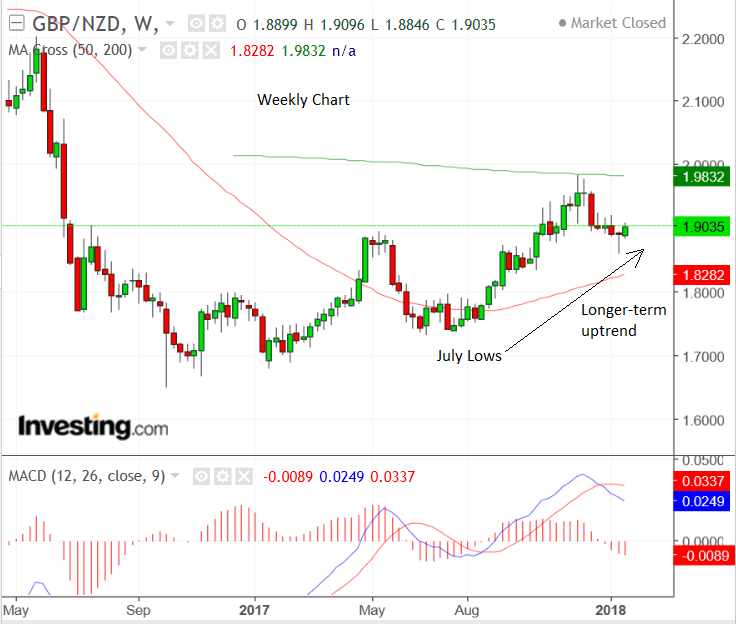Pound-to-New Zealand Dollar Rate Forecast for the Week Ahead

With pundits saying the Kiwi is at risk of a deep pull-back the Pound-to-New Zealand Dollar may be poised for gains in the coming week.
The GBP/NZD exchange rate is probably resuming its longer-term uptrend after rotating higher at the recent January 12, 1.86 lows.
Although the up-move has started to stall since the reversal, given the longer-term trend higher which began at the July 2017 lows, we expect it to continue.
On the daily chart below we also not how momentum, measured by MACD is bottoming out and rising, and thus supporting the nascent uptrend.
Part of the reason for the slowdown in upside may be due to the location of the 50-day moving average (MA) at 1.9177, which is likely to act as an obstacle to further upside as many traders will have set orders to exit the market at this point.
Moving averages often attract increasing selling pressure due to the emergence of short-term technical traders who bet on the market pulling-back from the Moving Average, and sometimes even cause pull-back due to the high volume of selling in in the zone.
We would, therefore, ideally like to see a clear break above the 50-day MA, confirmed by a move above 1.9250, before expecting a continuation higher to a probable target at 1.9500.
Get up to 5% more foreign exchange by using a specialist provider to get closer to the real market rate and avoid the gaping spreads charged by your bank when providing currency. Learn more here.
Data and Events for the New Zealand Dollar
The main release for the New Zealand Dollar (Kiwi) in the coming week is on Wednesday, January, when Inflation data for December is released at 21.45 GMT.
Inflation (CPI) is forecast to remain unchanged at 1.9% compared to a year ago and 0.4% compared to the previous month when it rose by 0.5%.
Higher inflation equals higher interest rates which equal a stronger Kiwi as it attracts more foreign capital drawn by the promise of higher returns - and vice versa for lower returns.
Price pressures are not forecast to be very strong, according to Managing Director of BK Asset Management Kathy Lien, who said, in her own week ahead piece that, "with manufacturing activity slowing and price pressures likely to be hit by lower food and dairy prices in the fourth quarter, the New Zealand dollar is at greatest risk for a deep correction."
Data and Events for the Pound
The two big releases for the Pound next week are Employment data and fourth quarter GDP.
Employment data for November is out on Wednesday at 9.30 GMT and is forecast to show the unemployment rate staying fixed at 17-year lows of 4.3%.
Wages are also likely to be in focus as they influence inflation which in turn influences interest rates and Sterling.
Higher wages, equal higher inflation, equals higher interest rates, equals higher Pound.
Wages rose by 2.5% in the previous month of October compared to a year ago and are expected to rise the same in November.
Unfortunately for workers, this is a half a percent below inflation at 3.0%, which means they are essentially getting poorer.
This suggests consumption may fall as people tighten their belts which will reduce growth.
Evidence of wages rising in December, however, from a new survey conducted by IHS Markit suggests a possibility of an upside surprise in Wednesday's earnings data, although the official data will be for the month before the IHS Markit data.
The other major release in the week ahead is Q4 GDP on Friday at 9.30.
Consensus estimates are for GDP to equal 1.4% in Q4 from 1.7% in Q3 reflecting the slowdown in the economy due to the corrosive effects of high inflation and businesses holding back from making investment decisions due to Brexit uncertainty.
A fall to the estimated 1.4% would mean the annual growth rate on a quarterly interval comparison basis will have fallen to lows not seen since 2009 - over eight years ago during the financial crisis.

(Image courtesy of tradingeconomics.com)
The quarterly rate, however, is forecast to remain at 0.4% like Q3, and the year-on-year data may reflect a more negative situation than the quarterly figures suggest.
The economy has shown and will continue to show resilience when GDP data is released, says IHS Markit Economist Bernard Aw.
"Preliminary estimates of UK GDP for the fourth quarter are eagerly awaited for confirmation that the economy continues to show resilience on the face of Brexit uncertainty," says Aw.
From a growth perspective, the outlook may be improving after recent conciliatory comments from French President Emmanuelle Macron and other leading EU figures suggested the UK could have a bespoke trade deal after Brexit, and consequently a softer-landing for the UK economy.
Get up to 5% more foreign exchange by using a specialist provider to get closer to the real market rate and avoid the gaping spreads charged by your bank when providing currency. Learn more here.






